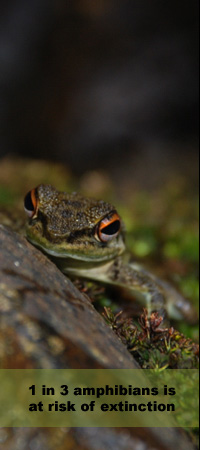|
Amphibians have been used around the world for food (subsistence and gourmet consumption), bait (e.g., salamanders as fishing bait), insect control, teaching (e.g., physiology from study of frogs), and research.
In research, amphibian eggs and larvae have been used in assaying of many synthetic substances to environmental and human health. Research on medicine using amphibians included fever therapy, pain killer, and many other applications to human health. The three most common frog genus used in laboratory are Xenopus, Rana, and Dendrobates. The most common laboratory amphibian species include mole salamander, African clawed frog, leopard frog, bullfrog, green frog, and poison arrow frog.
Recently extinct amphibians
Extinctions can be highly difficult to confirm due to the need of long term intensive field surveys. Using the most conservative approach to documenting extinctions, 34 amphibians are known to have vanished for ever since the year 1500 as a result of human activities. The majority of amphibian extinctions occurred during the last 100 years. However, the real number of extinct species is very likely to be an underestimate since amphibian inventories and monitoring are lacking in most parts of the world. Most scientists believe that more than 120 species are suspected to be extinct since the 1980s. Many of those “possibly extinct” amphibians have never been seen in the wild for decades!

Continue on page 4
|
|

The Long-nosed Horned Frog (Megophrys nasuta) from Southeast Asia has a loud resonating metallic call. © 2006 Olaf Leillinger

Capture of frogs for local food consumption in Asia. © 2007 Pierre Fidenci

Habitat of many amphibian species in a remote creek of Palawan, Philippines. © 2006 Pierre Fidenci

Click here and check out the Extinct Frog Gallery
|









